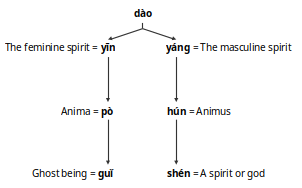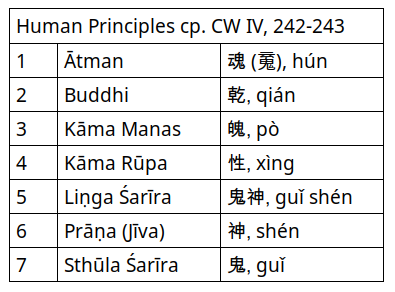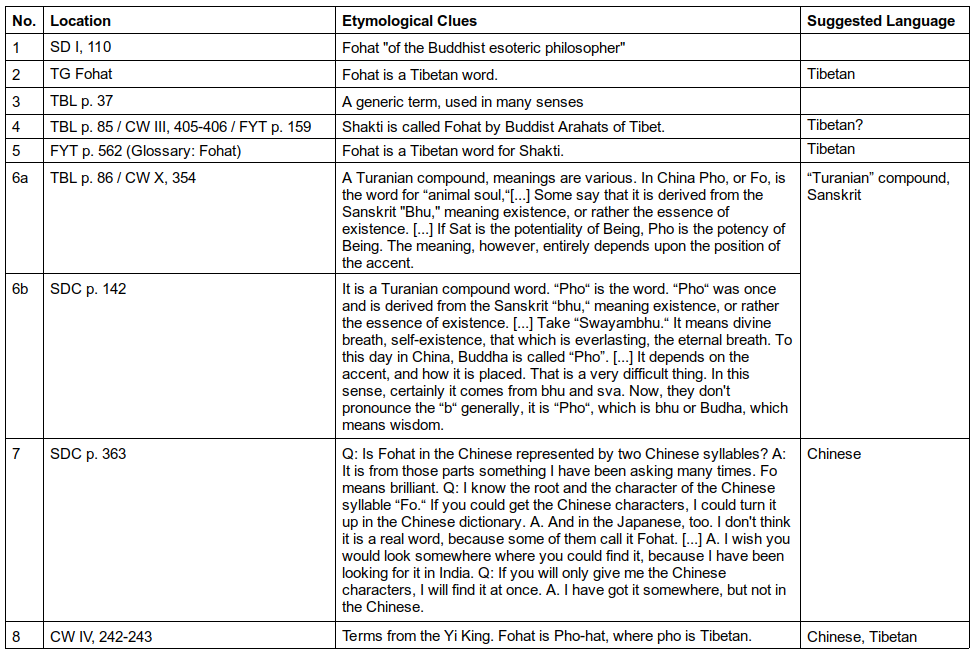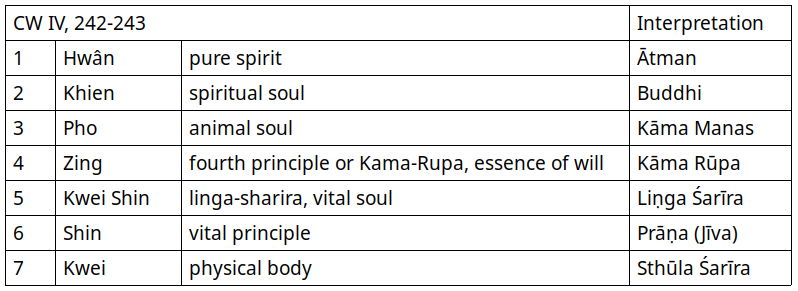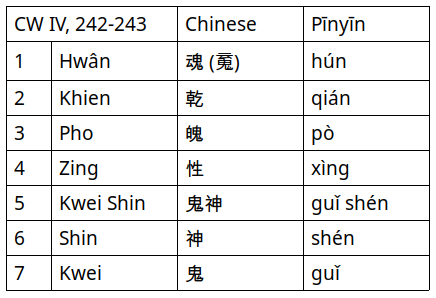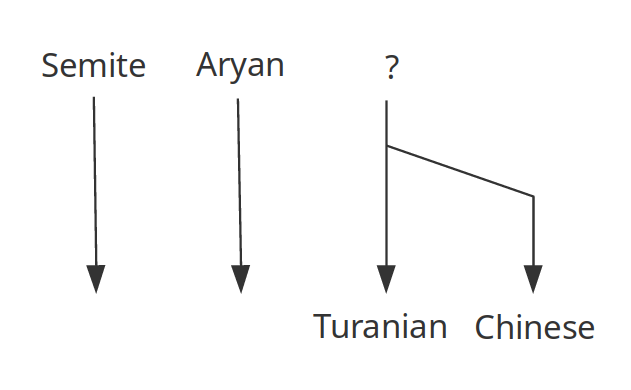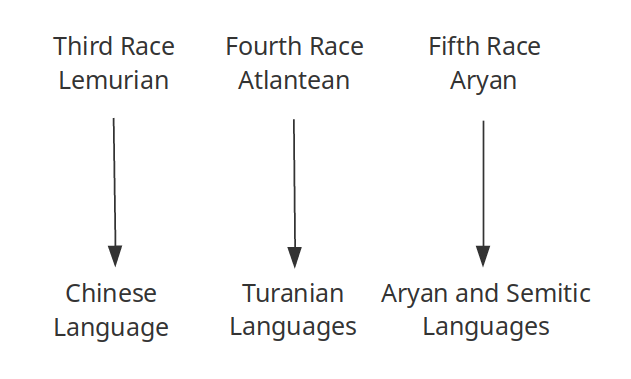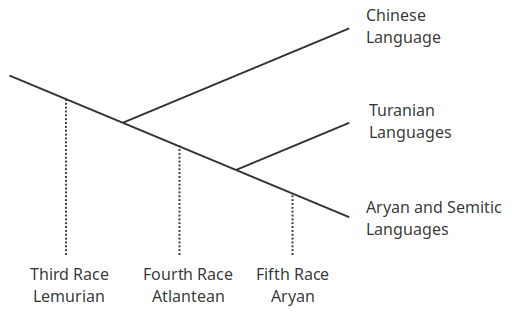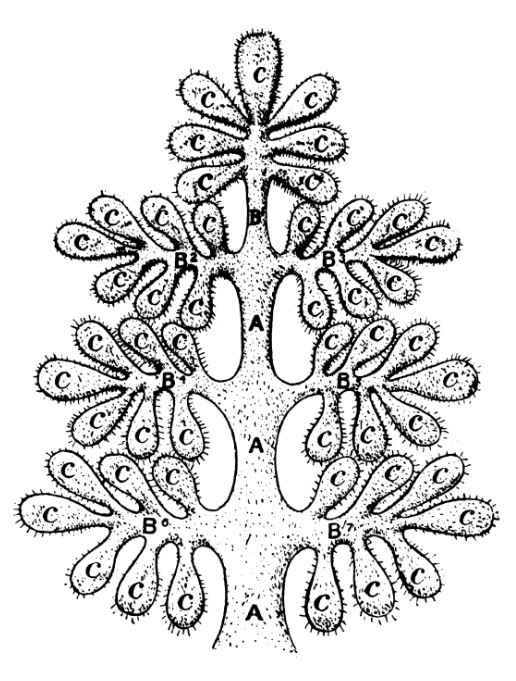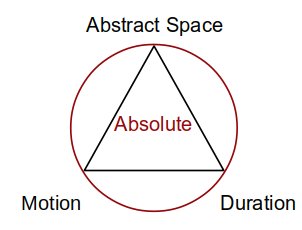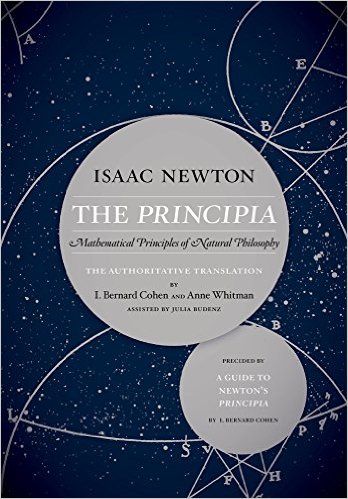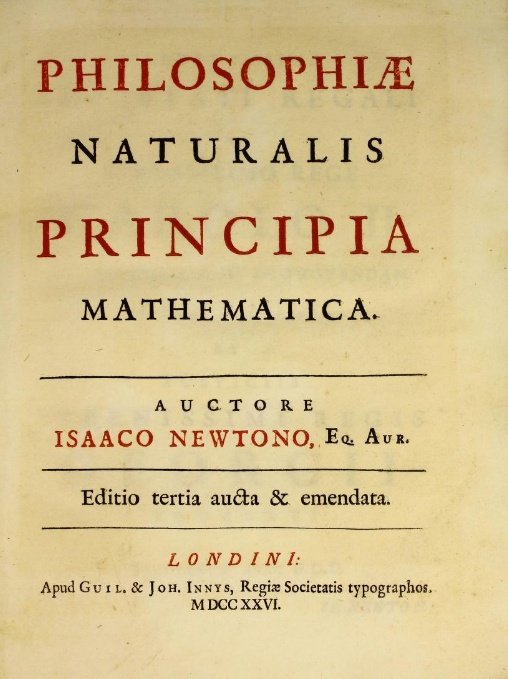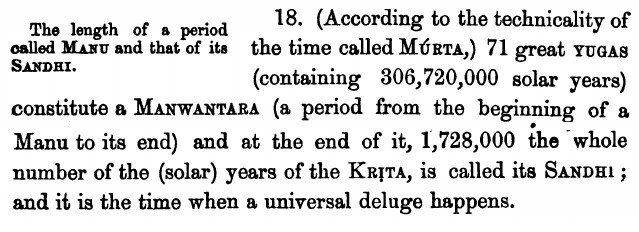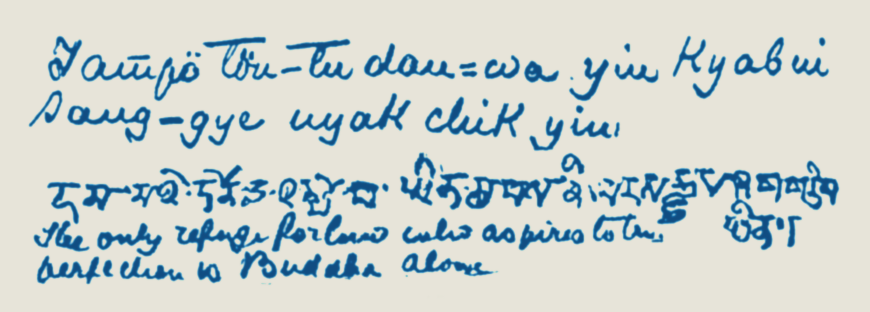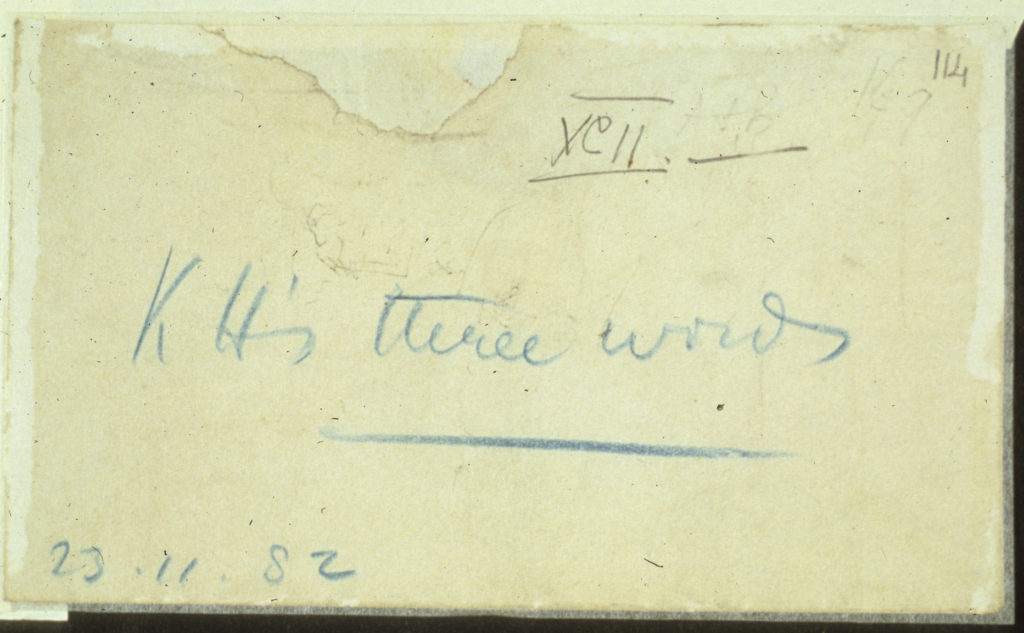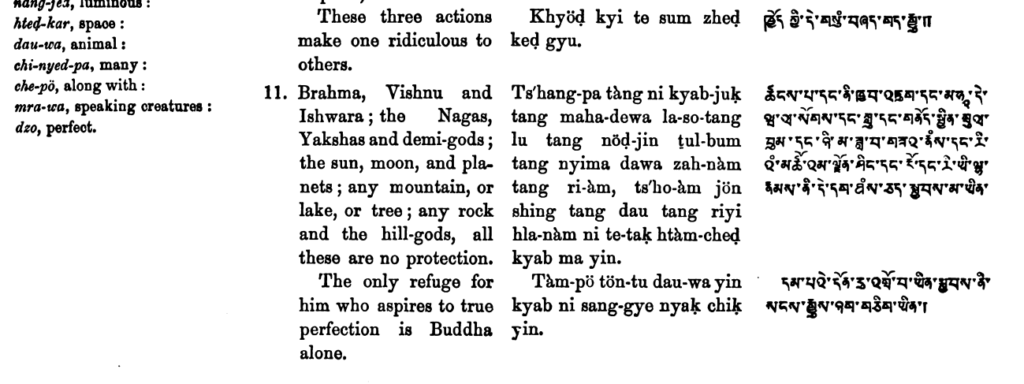“Creation Stories: The Cosmogony Account from the Buddhist Tantras,” posted on Dec. 25, 2013, gave an account of the arising of the cosmos from luminosity or clear light (prabhāsvara, ‘od gsal). This was likened to the actual moment of manifestation described in the Book of Dzyan, stanza 3, verse 3: “Darkness radiates light.” The next verse of the Book of Dzyan, stanza 3, verse 4, says: “Then the three fall into the four.” This, too, is paralleled in the known Buddhist tantras. In their practice manuals, called sādhanas, the fourfold cosmos is visualized as being generated from a triangular source. Yet, neither the arising of the cosmos from light, nor the three falling into the four are part of the more widely known cosmogony accounts coming from the Buddhist sūtras. These things are found only in the Buddhist tantras, referred to as the Books of Kiu-te in Theosophical writings.
To review, the Book of Dzyan is said by H. P. Blavatsky to be “the first volume of the Commentaries upon the seven secret folios of Kiu-te, and a Glossary of the public works of the same name.” (“The Secret Books of ‘Lam-rim’ and Dzyan,” Blavatsky Collected Writings, vol. 14, p. 422). The name Kiu-te is a phonetic rendering of the Tibetan word, rgyud sde, which designates the Buddhist tantras. An interesting comment about these books was made by the clairvoyant, C. W. Leadbeater, obviously referring to the seven secret folios of Kiu-te as the original of the Book of Dzyan. Some of his clairvoyant observations have been questioned by other Theosophists. This comment is here given for what it is worth, making no claims for it, other than to say that it is suggestive:
“The original of The Book of Dzyan is in the hands of the august Head of the Occult Hierarchy, and has been seen by none. None knows how old it is, but it is rumoured that the earlier part of it (consisting of the first six stanzas), has an origin altogether anterior to this world, and even that it is not a history, but a series of directions—rather a formula for creation than an account of it.” (Talks on the Path of Occultism, Volume II: The Voice of the Silence, by Annie Besant and C. W. Leadbeater,1926, p. 329)
The Buddhist tantra practice manuals describe what is called the generation stage, or creation stage, or development stage, which precedes the completion stage. In the generation stage, an idealized cosmos in the form of a particular tantra maṇḍala is visualized. The maṇḍala is the residence of the particular tantra deity, such as Kālacakra. The visualization begins with the generation of the cosmos. The tantra sādhana texts give directions for this. So they do indeed give a formula for creation.
In these texts creation begins with a triangular source, called the dharmodaya, the “origin of the dharmas,” within the infinite realm of space (anantākāśā-dhātu). The dharmas, often translated as phenomena, are the elements of existence that make up the cosmos in the Buddhist world-view. The dharmodaya is described as a triangle (trikoṇa). Book of Dzyan, stanza 3, verse 4, is given with some annotations in The Secret Doctrine, vol. 1, p. 66, as follows: “4. (Then) the three (triangle) fall into the four (quaternary).” Blavatsky’s following commentary discusses the use of geometrical figures in ancient scriptures, but it does not explain the triangle and its role in cosmogony. Later, however, in the meetings of the Blavatsky Lodge, Blavatsky explained the role of the triangle in cosmogony at length. These discussions were taken down in shorthand and partly published in Transactions of the Blavatsky Lodge, two parts, 1890 and 1891, and more fully in The Secret Doctrine Commentaries, 2010, and again in The Secret Doctrine Dialogues, 2014.
There in her comments on stanza 2, verse 3, Blavatsky said: “[T]he Point in the Circle is the Unmanifested Logos, the Manifested Logos is the Triangle. Pythagoras speaks of the never manifested Monad which lives in solitude and darkness; when the hour strikes it radiates from itself ONE, the first number. This number descending, produces TWO, the second number, and TWO, in its turn, produces THREE, forming a triangle, the first complete geometrical figure in the world of form. It is this ideal or abstract triangle which is the Point in the Mundane Egg, which, after gestation, and in the third remove, will start from the Egg to form the Triangle.” (Transactions of the Blavatsky Lodge, p. 83).
Further, in her comments on stanza 3, verse 3, Blavatsky said: “. . . the Triangle is the first perfect geometrical figure. As stated by Pythagoras, and also in the Stanza, the Ray (the Pythagorean Monad ) descending from ‘no-place’ (Aloka), shoots like a falling star through the planes of non-being into the first world of being, and gives birth to Number One; then branching off, to the right, it produces Number Two; turning again to form the base-line it begets Number Three, and thence ascending again to Number One, it finally disappears therefrom into the realms of non-being as Pythagoras shows.” (Transactions of the Blavatsky Lodge, p. 106).
The Buddhist tantra sādhanas had long been kept secret from those who had not received the required initiation. In recent years some of these have been published in English and thus made widely available. The full sādhana of the Guhyasamāja-tantra as arranged by Tsongkhapa for the Gelugpa tradition became available in 2019 in an excellent translation by Artemus B. Engle in the book, Guhyasamāja Practice in the Ārya Nāgārjuna System, Volume One, The Generation Stage. It instructs that the meditator should begin by visualizing from emptiness the vajra ground, and “at the center is a white, triangular entity-source with its large flat surface facing upward and its narrow tip embedded [in the vajra ground] below.” (p. 571). The triangular dharmodaya is here translated as the triangular entity-source. The extensive commentary on this sādhana, written by Tsongkhapa’s disciple Khedrup Je, became available in a full English translation by Yael Bentor and Penpa Dorjee in 2024 as Ocean of Attainments: The Creation Stage of the Guhyasamāja Tantra according to Khedrup Jé. Here the dharmodaya is translated as the source of phenomena. The translators summarize the practice:
“Here begins the actual creation of the ‘creation stage.’ After the entire world and its inhabitants—the yogi’s ordinary environment—are dissolved into emptiness, the ground of wisdom and the potential for all, the meditators begin to create the enlightened world of the maṇḍala.” (p. 97). “Next, Tsongkhapa’s Guhyasamāja Sādhana instructs to meditate on the ‘source of phenomena,’ which, as its name indicates, is the ground of all things. The source of phenomena is visualized as a triangular pyramid, standing on a point with its wide side pointing upward, empty inside, obviously indicating birth.” (p. 98). “The entire maṇḍala, with its celestial mansion and deities, that will be visualized in the sādhana is contained within the source of phenomena.” (p. 99).
So the three in “the three fall into the four” were explained by Blavatsky as a triangle, the first geometrical figure, and the only one possible to begin the manifestation process. Likewise in the Buddhist tantra sādhanas, teaching the creation stage, the first thing to arise in the visualization of the manifestation process is a dharmodaya in the shape of a triangle. From this triangle arises the four planes of existence, in Theosophical terminology, or the spheres of the four elements in Buddhist tantra terminology. Thus the three fall into the four, and actual manifestation occurs.
As said by Blavatsky, commenting on Book of Dzyan, stanza 2, verse 4: “[T]he Triangle, or the Three becomes the Four. . . . It is explained further on in the Secret Doctrine that practically there are only four planes belonging to the planetary chains. The three higher planes are absolutely Arupa [formless] and outside our comprehension.” (Transactions of the Blavatsky Lodge, p. 90).
In the Guhyasamāja sādhana, from a lotus inside the triangular dharmodaya, there appear sequentially an air or wind maṇḍala, a fire maṇḍala, a water maṇḍala, and an earth maṇḍala. Khedrup Je in his commentary briefly gives the correspondence between the successive appearance of the maṇḍalas of the four elements in the manifestation of the cosmos and the sequential visualization of them in the sādhana. The Panchen Lama Losang Chökyi Gyaltsen gives these in much more detail in his summary of Khedrup Je’s commentary, translated into English by Yael Bentor and Penpa Dorjee and published in 2019 as The Essence of the Ocean of Attainments. The section headings provide a good summary: “Meditation on the Ground of Wisdom in Correspondence with the Empty Eon That Follows the Dissolution of the Previous World,” pp. 95-98, and “Visualization of the Vajra Ground and Meditating on the Celestial Mansion in Correspondence with the Evolution of the Subsequent World,” pp. 105-108.
Very interesting is the section on the evolution of sentient beings in correspondence to the visualization of the maṇḍala. As Artemus Engle explains in Guhyasamāja Practice in the Ārya Nāgārjuna System, p. 244, the maṇḍala “deities that are produced through [an act of] devotion” (called “specially visualized deities” by Yael Bentor) correspond to the human beings of the first kalpa or eon. This is the “self-born” humanity of the first root-race described in The Secret Doctrine. In Buddhist sādhanas the deities are normally generated from a seed-syllable, followed by a symbol, and then the deity. But these deities in the Guhyasamāja sādhana appear spontaneously without being generated from a seed-syllable. As the sādhana says: “Merely by [an act of] devotion, the thirty-two deities appear in their complete form, instantly and simultaneously, upon those cushions.” (Engle, p. 577). So they are said to be like the human beings of the first kalpa, who were born spontaneously (upapāduka, rdzus te skye ba) (Engle, p. 243, fn. 799).
The source text giving the correspondences between the generation of the cosmos and of human beings to the generation stage visualizations taught in the Guhyasamāja sādhana, preceded by the destruction of the previous cosmos, is the Vyavastholi (referred to as Formulating the Sādhana or Formulating the Guhyasamāja Sādhana in the books by Yael Bentor). This brief text has not yet been translated into English, although we have the very helpful 2016 edition prepared by Kimiaki Tanaka, Samājasādhana-Vyavastholi of Nāgabodhi/Nāgabuddhi: Introduction and Romanized Sanskrit and Tibetan Texts (and the important philological notes thereon by Péter-Dániel Szánto, “Early Exegesis of the Guhyasamāja: Philological Notes on the Vyavastholi of Nāgabuddhi”). Tsongkhapa wrote a rather extensive commentary on it, also not yet translated into English. However, Tsongkhapa also wrote another commentary on the Guhyasamāja sādhana that includes quite a bit of information on these correspondences. It has been translated into English by Yael Bentor as Fulfilling the Bee’s Hope, included in her 2024 book, The Cosmos, the Person, and the Sādhana: A Treatise on Tibetan Tantric Meditation, With a Translation of Master Tsongkhapa’s Fulfilling the Bee’s Hope. This book has an extensive introduction that also draws heavily upon Tsongkhapa’s commentary on the Vyavastholi.
Here, p. 60, Yael Bentor summarizes what the Vyavastholi does: “Nāgabuddhi’s Formulating the Guhyasamāja Sādhana . . . points to correlations between the sādhana and stages of the evolution and destruction of the world—as well as the death, intermediate state, and rebirth of the inhabitants of the world. Nāgabuddhi describes the stages of the destruction and evolution of the world in relation to the dissolution of the meditator’s ordinary environment and the creation of the celestial mansion of the mandala.”
Tsongkhapa in Fulfulling the Bee’s Hope says, p. 158: “. . . the object to which this meditation corresponds, the formation of the physical world, is explained in Formulating the Guhyasamāja Sādhana. How does [the meditation here] correspond [to the evolution of the physical world]? The meditation on the wind mandala corresponds to the evolution of the wind mandala on the ground of ordinary existence [during the evolution of the physical world], and likewise do the three other mandalas [of fire, water, and earth].”
Tsongkhapa describes the dissolution of the previous world, when seven suns succesively arise and completely incinerate it (p. 154). Then how the world re-arises from a wind that comes about through the shared karma of the living beings of the previous world, producing the air, water, and earth maṇḍalas and the oceans and mountains (p. 156). Then how the world is re-populated, when beings from the highest heaven (which, being formless, had escaped the incineration of the world of form) are reborn in the next lower heaven, and so on until the whole world including the hell realms below it are re-populated (p. 159). All this exactly follows, and is taken from, the Buddhist Abhidharma texts and the Abhidharma account given in the Yogācāra-bhūmi.
Here in our continent, Jambudvīpa, the beings of the first eon (kalpa) are described by Tsongkhapa as follows (pp. 159-160): “(1) they are adorned with features similar to the major and minor marks of a buddha, (2) their lifespan may be infinite, (3) their faculties are complete, (4) they can travel in the sky by means of miraculous powers, (5) being free of dependence on physical food, they subsist solely on delight, (6) there being no distinction between day and night [no sun and moon], their bodies can illuminate with a light of their own, and (7) their birth is miraculous.” This is like the description of the ethereal first root-race humanity given in The Secret Doctrine, the spontaneously generated “self-born” (Book of Dzyan, stanza 5, verse 20, stanza 6, verse 23, and stanza 7, verse 25, all in volume 2).
Tsongkhapa then recounts how their bodies gradually become coarser and coarser (pp. 160-161). Now they can no longer travel in the sky by means of miraculous powers, and their bodies no longer radiate a light of their own. Eventually, these once sexless beings develop sex organs, some male and some female. Such is the beginning of sexual reproduction as we now know it. This is the separation of the sexes described in The Secret Doctrine as occurring in the third root-race (Book of Dzyan, stanza 8, verse 31). Again, all of the above exactly follows, and is taken from, the Buddhist Abhidharma texts and the Abhidharma account given in the Yogācāra-bhūmi.
As may be seen, Tsongkhapa brings in the standard Buddhist cosmogony account as given in the Abhidharma texts in correspondence to the generation stage practices of the Guhyasamāja sādhana. However, the triangular dharmodaya from which the maṇḍalas of the four elements are generated in the sādhana is not found in the Abhidharma account. Similarly, the triangular dharmodaya in the Buddhist tantra sādhana account does not arise from luminosity or clear light (prabhāsvara, ‘od gsal), which is the origin of the cosmos in the Buddhist tantra account of cosmogony described in a previous post (http://prajnaquest.fr/blog/creation-stories-the-cosmogony-account-from-the-buddhist-tantras/, see also: http://prajnaquest.fr/blog/prabhasvara-in-the-canonical-texts-and-in-cosmogony/). So we have three differing Buddhist accounts of cosmogony:
1. The standard Buddhist account as summarized from the Buddhist sūtras in the Abhidharma-kośa and its auto-commentary (http://prajnaquest.fr/blog/creation-stories-the-cosmogony-account-from-the-abhidharmakosa/), or in the Yogācāra-bhūmi (http://prajnaquest.fr/blog/creation-stories-the-cosmogony-account-from-the-yogacarabhumi/). The cosmos arises from the collective karma or actions of living beings in the form of a primordial wind (vāyu). There is no mention either of luminosity/clear light (prabhāsvara, ‘og gsal) or of the triangular source (dharmodaya).
2. The account from the Buddhist tantras as summarized in four verses from the Svādhiṣṭhāna-prabheda that were often quoted in other tantric texts (http://prajnaquest.fr/blog/creation-stories-the-cosmogony-account-from-the-buddhist-tantras/). The cosmos arises from luminosity or clear light (prabhāsvara, ‘od gsal), with no mention of a triangular source (dharmodaya).
3. The account from Buddhist tantra practice texts, called sādhanas. An idealized cosmos is visualized as arising from a triangular source (dharmodaya), with no mention of luminosity/clear light. Later in the Guhyasamāja sādhana, however, the principal deity at the center of the maṇḍala is dissolved into luminosity/clear light, from which this deity re-arises in the following phase of the sādhana.
These three differing accounts need not be seen as mutually contradictory. When speaking in broad, general terms, the Buddhist tantras say that the cosmos arises from luminosity or clear light (prabhāsvara, ‘od gsal). More specifically, the Buddhist tantra practice texts give directions for visualizing the generation of an idealized cosmos from a triangular source (dharmodaya). Taking the Guhyasamāja practice texts as a model, elaborate correspondences are given to the generation of the cosmos taught in the Buddhist Abhidharma texts, including its arising from the collective karma of living beings in the form of a primordial wind (vāyu). The visualized generation of an idealized cosmos in Buddhist tantra practice texts is presented as being closely parallel to the actual generation of the cosmos as described in the Buddhist Abhidharma texts.

